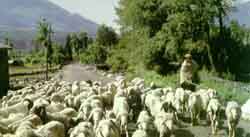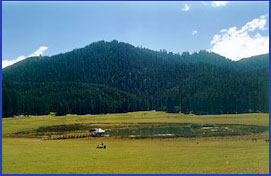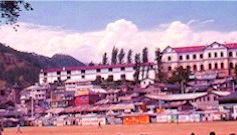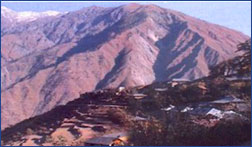| Destinations
|
|||
 Dalhousie (2039 m) established in 1854 by the British Governor General Lord dalhousie, is today a little hill station that still retains much of it's charm. It is easily accessible from the plains. Pathankot, the nearest railhead is 90 km away and luxury coaches, buses and taxis take visitors up to this unspoilt hill station. Built around five hills, Dalhousie is clothed in stately groves of deodhar and oak. It's marvellous forest trails overlook vistas of wooded hills, water falls, spring & rivulets. There are also magnificent views of the Chamba Valley and the mighty Dhauladhar range with its awe-inspiring snow covered peaks filling the entire horizon.
Dalhousie (2039 m) established in 1854 by the British Governor General Lord dalhousie, is today a little hill station that still retains much of it's charm. It is easily accessible from the plains. Pathankot, the nearest railhead is 90 km away and luxury coaches, buses and taxis take visitors up to this unspoilt hill station. Built around five hills, Dalhousie is clothed in stately groves of deodhar and oak. It's marvellous forest trails overlook vistas of wooded hills, water falls, spring & rivulets. There are also magnificent views of the Chamba Valley and the mighty Dhauladhar range with its awe-inspiring snow covered peaks filling the entire horizon.
Dalhousie still has a touch of the 'Raj' about it and its colonial style buildings and houses bring back the flavour of an earlier era. A veneer of Tibetan culture has added a touch of the exotic to this serene resort and along road-sides are huge rocks carved in low relief and painted in the tibetan style. Around Dalhousie: Subhash Baoli (2085 m): A splendid walk from the GPO square leads up to the spring with its panoramic views of the snow capped mountains. (1.6 km) Satdhara (2036 m): Close to the town, enroute to Panjpulla, are the seven sparkling springs of Satdhara rich in mica and noted for its medicinal properties. Panjpulla: Another pretty spot where the water from a natural tank flows under five small bridges. (2 km) |
More on Himachal • At a Glance • Chamba • Dharamsala • Jwalamukhi • Kinnaur • Mandi • Manali • Palampur • Renukaji • Sarahan • Shimla • Temples • Spiti
Travelogues Adventure • Mountaineering • Trekking • Rafting • Paragliding • Rock climbing |
||
Bakrota Hills (2085 m): Not too far from the centre of the town is the Bakrota Mall, the 5 km popular walking circuit with splendid views of the mountains.
Kalatope (2440 m): Its scenic splendour, forest rest house and fine views of the surrounding country make it an ideal spot for a weekend retreat. The little Kalatope Sanctuary has a variety of wildlife. (8.5 kms) Bara Pather (4 kms): Set amidst thick forests is the small temple of Bhulwani Mata, in the village of Ahla, on the way to Kalatope. A fair is celebrated in July to venerate the goddess. Dainkund (2745 m): This tall peak outside town affords a birds eye view on a clear day, of the hills, verdant valleys and the rivers Beas, Ravi and the Chenab threading their silvery way down to the plains. (10 km)
Chamba
Just 56 km from Dalhousie, situated at a height of 996 m above sea level, Chamba still has a medieval feel about it. Founded in 920AD by Raja Sahil Varma, the little town, perched on a plateau overhanging the river Ravi, was named after his favourite daughter Champavati. Isolated by the high mountains in its beautiful valley, Chamba was allowed over the centuries to develop its own rich style of Pahari art and architecture. Much of this heritage has been preserved and Chamba is known today for the spendour of its temples and its exquisite handicrafts.
Still intact are a fine group of six ancient stone temples with tall vimanas, dedicated to both Shiva and Vishnu, dating from 8AD. The richly carved Lakshminarayan temple is the oldest structure in this group.
Other evidence of Chamba's rich past are to be found in the Bhuri Singh Museum, with its collection of exquisite miniatures from the kangra, Basholi and Chamba schools of painting as well as murals and artefacts from the Rang Mahal Palace.
The Hari Rai temple near the Chaugan dates back to the 11th century and is noted for its exquisite bronze image of Chaturmurti - the four armed Vishnu.
Just 1 km away from the Chaugan is another temple dedicated to the goddess Chamunda Devi. It overlooks the river and the town and is noted for its fine wood carving.
Around Chamba:
Katasan Devi Temple: A popular place of pilgrimage, the temple has a beautiful view of the Chamba Valley. (30 kms)
Sarol: Lovely landscaped gardens, a sheep breeding centre and apiary make Sarol an interesting place for picnics. (11 km)
Jhamwar: Located amid dense forests, Jhamwar is noted for its apple orchards (10 kms).
Saho - Situated on a high plateau on the bank of the river Sal, it is famous for the temple to the Lord Chandrashekar - Lord Shiva with his moon crown.(20 kms)
Other Places of Interest:
Salooni (1829 m): Another place with breathtaking views of the snow-capped ranges. (56 km)
Bhandal Valley (1831 m): just 22 km from Salooni is the beautiful Bhandal Valley with its wealth of wildlife - an ideal retreat.
Pangi Valley (2438 m): 137 km north-east of Chamba is the wild & beautiful Pangi valley in the rain shadow of the ranges, noted for its beautiful people and colourful folk dances. From Killar, located in the deep gorge of the Chenab, there are exciting treks to Keylong, Mandi and to Kishtwar in Kashmir.
Bharmaur
Capital of the Chamba Valley for over 400 years, Bharmaur (2195m) dates back to the rule of King Meru Varman (680 AD700 AD). A fascinating little town surrounded by high ranges, it's ancient temples endow it with the aura of a hallowed place. The region is also home to the seminomadic Gaddis - the shepherds of this area.
Life in Bharmaur centres around the temple square - the Chaurasia, which owes its name to the 84 shrines built within its periphery. The beautiful shikara, of Manimahesh temple dominates the square. A life size image of Nandi in polished brass stands before it.
Around Bharmaur:
Manimahesh (4170 m) an important place of pilgrimage, 34 km away, is awe inspiring in its stark grandeur, with the towering, solitary peak of the Manimahesh Kailash (5656 m) mirrored in the still waters of a little lake. Bands of pilgrims singing devotional songs wend their way up the arduous track to bathe in the icy lake and to worship at the little temple there. Thousands of people come for the main pilgrimage the Manimahesh Yatra in Aug. /Sep.
Chhatrari: The Shakti Devi temple here is of great archaeological importance (40 kms)
Kugti: The last inhabited village of Bharmaur is not too far from the Kugti Pass (5040m) and is on the challenging trail from Bharmaur to Keylong
Overlooking splendid forests of conifer, Kugti has a little forest rest house. The famous temple of Keylong Wazir - is 2 km away.
|
|||
Editor: Romola Butalia (c) India Travelogue. All rights reserved. |
|||

 Khajjiar (1851 m): While it is possible to go by road, Khajjiar is just a pleasant one day walk from Dalhousie (22 km). A picturesque spot with an, emarald, saucer shaped meadow set amidst a dense deodhar forest, it has a lake at its centre with a floating island, a forest rest house, a little temple with a golden spire and a golf course.
Khajjiar (1851 m): While it is possible to go by road, Khajjiar is just a pleasant one day walk from Dalhousie (22 km). A picturesque spot with an, emarald, saucer shaped meadow set amidst a dense deodhar forest, it has a lake at its centre with a floating island, a forest rest house, a little temple with a golden spire and a golf course.
 The Chaugan, a grassy meadow forms the heart of the town - the centre of its cultural activities. Each year in July/August, the Minjar fair is held here, when gods and goddesses are brought down from their mountain homes to the sound of drums and music, to pay homage to Lord Raghuvira. During the week-long harvest fair, the Chaugan comes alive as villagers dressed in colourful costumes celebrate with song, music and sport.
The Chaugan, a grassy meadow forms the heart of the town - the centre of its cultural activities. Each year in July/August, the Minjar fair is held here, when gods and goddesses are brought down from their mountain homes to the sound of drums and music, to pay homage to Lord Raghuvira. During the week-long harvest fair, the Chaugan comes alive as villagers dressed in colourful costumes celebrate with song, music and sport.
 Bharmaur is 65 km away from Chamba along an attractive hill road that follows the river for much of its route. Bharmaur is the base for the famed Manimahesh Yatra and for various marvellous treks in the region.
Bharmaur is 65 km away from Chamba along an attractive hill road that follows the river for much of its route. Bharmaur is the base for the famed Manimahesh Yatra and for various marvellous treks in the region.